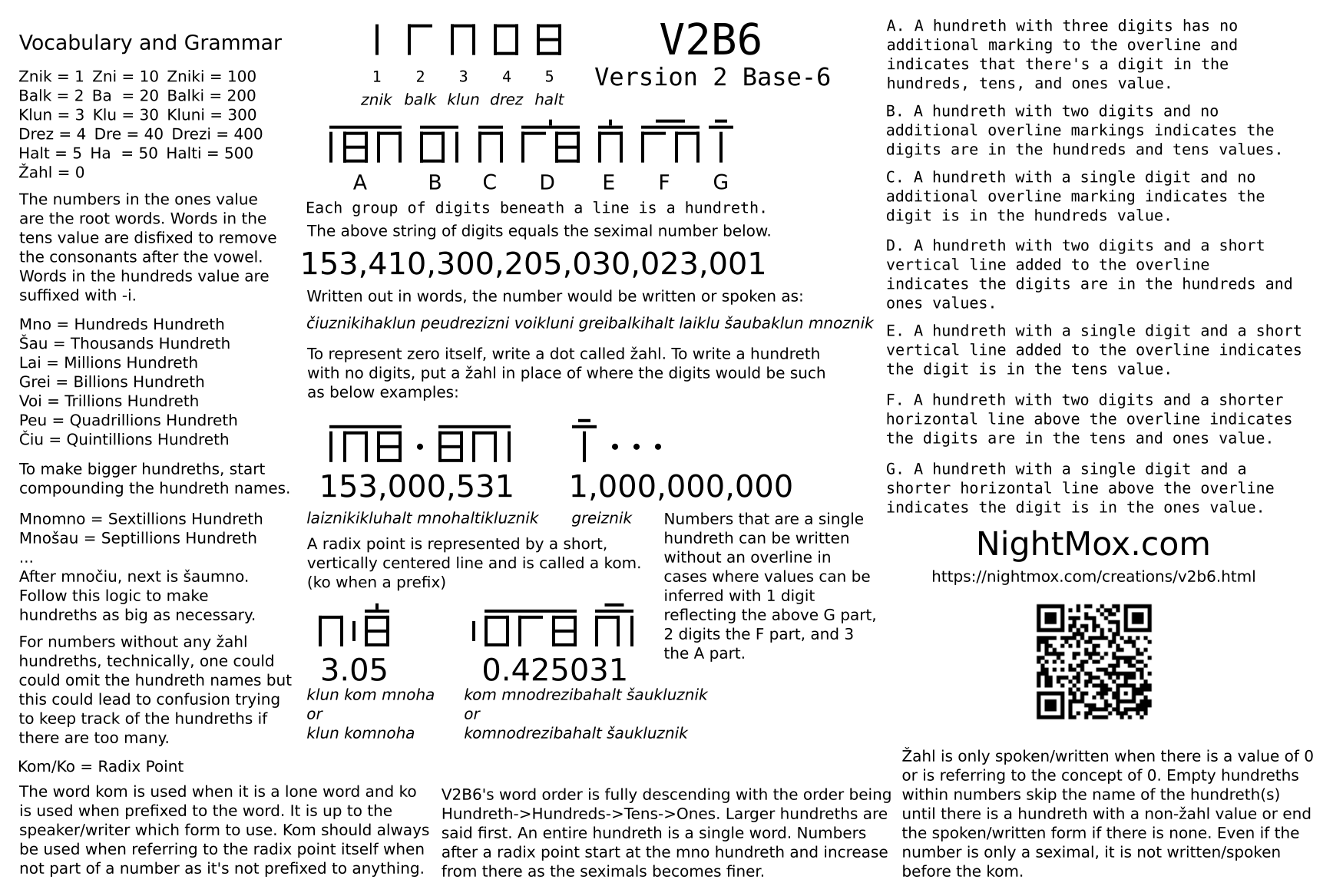About V2B6
V2B6 (Version 2 Base-6) is a seximal numeral system I created on 2019-12-19 that uses lines to create boxes as each number gets larger starting with 1 which is written as a single line and ending with 5 which is written as a square or rectangular box with a horizontal line going across the center. The numbers are then grouped into a set 1-3 digits with one or two lines above them to represent the value of the digits below. I call each of these sets of numbers 'hundreths' as each set resembles how we separate the values of Indo-Arabic numerals by every three numbers with commas or periods to make the hundreds values, thousands, millions, etc. A single line above a hundreth means that the number(s) below start at the hundreds spot like how we know numbers as one hundred, one hundred thousand, one hundred million, etc. A line is required even if there are 3 digits in a hundreth. A line with a small vertical line on top of it means that either the single digit beneath the lines is in the tens spot or two digits beneath are in the hundreds spot and the ones spot. A line with a slightly shorter horizontal line above it means either the single digit below them is in the ones spot or two digits below are in the tens spot and the ones spot. These lines are essential to determining the value of the digits below them. If a hundreth has no digits in it, then a dot is used. A dot can also be used to represent a lone zero. Although V2B6 uses lines to represent the value of digits and doesn't use zeros, it can easily be translated into Indo-Arabic numerals and vice versa if you understand how it works.
 Old guide
Old guide
V2B6 also uses non-English words to say the numbers. In the ones spot of a hundreth, 1-5 is Znik, Balk, Klun, Drez, Halt. In the tens spot, you just remove the consonants after the vowel so counting by the tens spot, 10-50 would be Zni, Ba, Klu, Dre, Ha. In the hundreds spot, you add 'i' to the end of the original words so counting by the hundreds spot, 100-500 would be Zniki, Balki, Kluni, Drezi, Halti. Each hundreth also has a name, the hundreds hundreth is Mno, thousands is Shau, millions is Lai, billions is Grei, trillions is Voi, quadrillions is Peu, quintillions is Chiu. The name of the hundreth comes before the numbers in the hundreth, opposite of how we say numbers in English. The words for the numbers and the word mno come from words for numbers of a conlang I worked on a very little amount years ago but some of the words for the numbers have been modified to sound better. So for example, the year 2021 in base-6 is 13205 and in V2B6 you would say shau zni klun mno balki halt.
I made this numeral system as better version of a numeral system I wrote down maybe a couple years before I made V2B6. The old, original concept, which I called V1B7 after making and naming V2B6 was a Base-6 or Base-7 bijective numeral system that used symbols above a line to show the values of the 1-3 digits below it and each symbol was unique for each value such as the tens, hundreds, thousands, etc. I had no idea how to make a numeral system without zeros at the time so it remained mostly a concept until I went back to it and ended up making V2B6, greatly improving upon what I had made before.
Additional Notes
- When writing the digits for 2 and 3 (balk and klun) the horizontal line when writing the digits is always on the top.
- Shau can also be spelled as šau.
- V2B6 is read left to right but it's helpful to count hundreths from right to left.
- Added peu and chiu/čiu on 2021-7-3 when making the visual guide.
- Zero in V2B6 is pronounced zhahl/žahl.
- Added seximals with 2024-10 update.
Written 2021-6-11 Published 2021-8-1 Updated 2024-10-1